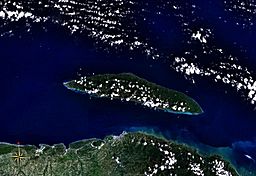Tortuga (Haiti) facts for kids
Quick facts for kids Tortuga Island (Île de la Tortue) |
|
| (Kréyol: Il Latòti) | |
| Island | |
|
Tortuga seen from space
|
|
| Name origin: Tortuga, Spanish for turtle | |
| Country | Haiti |
|---|---|
| Département | Nord-Ouest |
| Arrondissement | Port-de-Paix |
| Commune | Île de la Tortue |
| Highest point | Morne La Visite |
| - elevation | 340 m (1,115 ft) |
| Length | 37 km (23 mi) |
| Width | 7 km (4 mi) |
| Area | 193 km² (75 sq mi) |
| Population | 30,000 (2004) |
| Discovered | 1492 |
| - Settled | 1625 |
| Timezone | EST (UTC-5) |
| - summer (DST) | DST (UTC-4) |
Île de la Tortue (Tortuga Island in English, Il Latòti in Kréyòl) is a Caribbean island that forms part of Haiti, off the northwest coast of Hispaniola. Its Taíno name was Baynei.
During the 17th century, the island was an important centre for Caribbean piracy where pirates traded their stolen goods from ships and towns and stayed for days before going out to try to capture other ships.
Contents
Geography
In geology, it is considered as the western end of the region of the Cordillera Septentrional ("Northern mountain range") of the Hispaniola island, even if Tortuga Island is separated from the main island.
Tortuga Island is separated of the north coast of Haiti by an 8.9 to 15 km strait called the Canal de la Tortue ("La Tortue Channel"). The island is 37.5 km long and about 7 km wide, with an area of 193 km². There are not high mountains but most of the land is between 240 and 300 metres high; the highest point is Morne La Visite (340 m).
The island is a commune (like municipality), in the Nord Department. It is part of the Port-de-Paix arrondissement, part of a department like a district.
Population
In 2004, there were 30,000 people living in the Tortuga Island. There are only small towns; Aux Palmistes, in the southeast, is the biggest town in the island.
History
Christopher Columbus saw this island on 6 December 1492 and visited it on 14 December. He called the island La Tortuga, Spanish for "The Turtle", because it has the shape, when seen from the sea, of a turtle.
Spanish people were not interested in Tortuga Island because they were trying to form a colony in the big Hispaniola island. And so this island was without people for most of the 16th century.
People from different European countries, mainly from England, came to live in this island. In 1625, French people came to this island from the Saint Kitts island. They lived on the southern part of the island where there are flat lands and tried to grow some crops like tobacco. They also went to Hispaniola, which they called la Grande Terre ("the Big Land") to hunt wild cows and pigs and, because they used a Taíno cooking technique with smoke known as "boucan", they were known as boucaniers ("buccaneers"). They sold the smoked meat and leather (dry skin used to make footwear and clothing) to those ships that came to the island.
The Spanish tried to get those people out of the island and they invaded the island several times but each time they went back to the Hispaniola and the Tortuga Island was taken again. In 1640 a French engineer named Jean La Vasseur was sent to govern Tortuga. He built Fort de Rocher [1640]. La Vasseur opened the port to outlaws of all nations.
From Tortuga Island, people began to move to the northern part of the Hispaniola, mainly in the areas around the big plains, founding towns such as Port-de-Paix (1665), Cap-Français (1670) and Fort-Dauphin (1731). Then Tortuga Island lost its importance and very few people have lived here after those years, including today.
Tourism
There is several good beaches in Tortuga Island; Point Saline, at the western tip, is considered by many to be the best beach of the island.
At Basse-Terre, on the southeastern coast, there are still some rests of the Fort de la Roche built in 1630 by the French.
There are several interesting caves such as La Grotte au Bassin, La Grotte de la Galerie and others.
Images for kids
See also
 In Spanish: Isla de la Tortuga (Haití) para niños
In Spanish: Isla de la Tortuga (Haití) para niños



